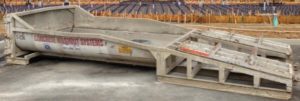Toll Free
(877) 698-8473As a contractor in the construction industry, you need an easy solution for managing your concrete waste to keep your job site clean and your site preparation on schedule. For this reason, providing a designated concrete washout area is probably one of your most significant concerns.
The concrete washout containers from Pacific Sanitation are designed for easy setup and enable you to keep your construction site eco-friendly and EPA compliant.
What Are Concrete Washout Systems? Why Do You Need Them?
After concrete is poured, equipment including wheelbarrows, hand tools, and the chutes and hoppers of concrete pump trucks have to be cleaned out to remove any residual concrete before it hardens. Before the turn of the century, most concrete washout measures involved constructing washout pits where tools and equipment could be cleaned.
However, this has since proved to be an environmentally harmful practice since concrete can cause irreparable damage to topsoil. The Environmental Protection Agency (EPA) requires site managers to ensure proper concrete waste management and containment on their projects.
Some control measures include lining designated washout areas with hay bales and plastic, but this is still not effective enough. These washout pits are easily damaged and can overflow due to rainfall washing slurry into storm drains, which discharge to surface waters such as lakes and estuaries.
The best management practices for concrete washouts have to securely contain the wash water and solids and are preferably portable and reusable. To be fully compliant and meet EPA standards, a washout area must be:
- A designated area to collect and retain the aggregate concrete washout slurry in leak-proof containers. Concrete wash water is a caustic material that’s damaging to both the environment and human skin.
- A recycling system that allows the collected concrete washout water plus solids to be diverted from landfills.
- In a location that provides convenient access to concrete trucks.
- Kept at least 50 feet away from storm drains and open ditches.

Enter concrete washout boxes – a cost-effective solution to an industry-wide problem that makes compliance easy.
Pacific Sanitation Concrete Washout Boxes
Concrete washout boxes are an environmentally safe concrete waste management and disposal mechanism that allow for the efficient collection and recycling of concrete washout water or solids. They’re a convenient portable solution allowing you to dispose of industrial concrete, drywall, stucco, paint, and other construction waste in an eco-friendly manner.
The washout boxes from Pacific Sanitation are water-tight containers engineered to withstand the elements and stay on a construction site for an extended period. Not only are they quick to set up, but they’re also highly portable, allowing you to transport them from one area to another. Their leak-proof design ensures that the wash water does not runoff into storm drains, local waterways, or soul surfaces.
Concrete boxes are an EPA-friendly way to contain hazardous washout material. The container designs are innovative, equipped with built-in ramps that enable pump trucks and ready-mix trucks to back onto the boxes. The heavy-duty, water-treated fiberboard boxes are designed to minimize concrete washout spillage allowing you to avoid environmental fines.
Choosing a Concrete Washout Container
Concrete washout boxes are a reliable solution for concrete wash water containment and disposal. Moreover, choosing the right size containers can increase productivity and reduce labor costs by lowering washout man-hours.
Pacific Sanitation offers concrete washout containers ranging from 5 to 40 cubic yards, depending on your construction site needs.
- The 5.5 CY concrete washout box can handle approximately 350 yards of material which equates to about 35 ready-mix trucks and two pump trucks.
- The 10 CY box is perfect for solid heavy material, including source-separated asphalt and masonry bricks.
- While the 20CY cannot be used for extremely heavy materials, it’s excellent for home remodeling and small construction projects.
- The 30 CY is ideal for larger construction and major renovation projects, while the 40 CY is reserved for the largest of projects such as skyscrapers and road construction.
It’s important to note that some materials cannot be poured into concrete washout boxes. These include hazardous materials such as wet paint, herbicides, and pesticides. Other prohibited materials include appliances containing refrigerants or propane as well as batteries, light fixtures, or computer monitors. For some of these products (such as appliances or fixtures disposal), dumpster rental might be more appropriate.
By following proper concrete box use guidelines, you can prevent discharge of concrete washout into the local waterways and groundwater system, enabling you to meet EPA guidelines and perhaps score some LEED points in the process. Not to mention they’re more affordable than building a washout container on site.
Keep Your Jobsite In Compliance with Pacific Sanitation
If you’re in need of a washout container that will sit for months, our concrete washout boxes fit the bill.
You know your projects must be compliant. EPA fines can be staggering, but compliance is easy with Pacific Sanitation washout boxes. You can save time and money by investing in concrete washout boxes that will get the job done and help you stay away from on-site liabilities. The best concrete washout containers are those that are easy to store, set up, and dispose of, which means you can’t go wrong with Pacific Sanitation.
Our concrete washout containers are EPA-friendly and allow for easy storage and transportation. They’re designed to withstand the harshest of environmental conditions while maintaining their portability and ease of setup. This way, they can sit on your job site for the duration of the project no matter the weather or circumstances you encounter.
Concrete washout containers should be inspected regularly (at least once per week) and after rains to check for leaks or damage, particularly if made from hay bales and plastic. Be sure to vacuum off the contents when the washout container is filled to about 75 percent to avoid overflows.
Contact us for the best concrete management and containment solution you’ll ever find.